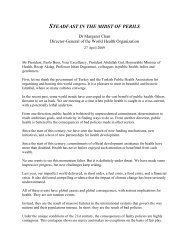The Evolution of HTA in Emerging Markets Health-Care ... - TREE
The Evolution of HTA in Emerging Markets Health-Care ... - TREE
The Evolution of HTA in Emerging Markets Health-Care ... - TREE
You also want an ePaper? Increase the reach of your titles
YUMPU automatically turns print PDFs into web optimized ePapers that Google loves.
OHE Consult<strong>in</strong>g Report for PhRMA<br />
5 January 2011<br />
A3.1 Overview <strong>of</strong> Taiwanese <strong>Health</strong> <strong>Care</strong> F<strong>in</strong>anc<strong>in</strong>g, Insurance,<br />
and Delivery System<br />
S<strong>in</strong>ce 1995, the health care system <strong>in</strong> Taiwan is known as National <strong>Health</strong> Insurance (NHI), which is a<br />
premium-‐based, s<strong>in</strong>gle-‐payer, mandatory, near-‐universal <strong>in</strong>surance program run by the government<br />
to allocate health-‐care funds. <strong>The</strong> system promises access to all necessary health care for citizens<br />
with national identity cards. In 2000, the coverage already amounted to over 96% <strong>of</strong> the total<br />
eligible population, and that percentage has <strong>in</strong>creased each year s<strong>in</strong>ce NHI first began.<br />
More than 80% <strong>of</strong> health providers are private organizations: this provides market competition for<br />
the delivery <strong>of</strong> health services to Taiwanese citizens. Given that reimbursement is on a fee-‐for-service<br />
basis, pr<strong>of</strong>it-‐maximiz<strong>in</strong>g cl<strong>in</strong>ics would have an <strong>in</strong>centive to provide some “unnecessary” (i.e.,<br />
low-‐yield) services, exam<strong>in</strong>ations, or procedures to their patients s<strong>in</strong>ce government is cover<strong>in</strong>g the<br />
bill. <strong>The</strong> Bureau <strong>of</strong> National <strong>Health</strong> Insurance (BNHI), which oversees the NHI program, has long<br />
recognized the need to prevent this type <strong>of</strong> misallocation and conta<strong>in</strong> its costs. In 2002, they<br />
changed the NHI from a fee-‐for-‐service model to a global budget system.<br />
A3.2 Population, coverage, expenditure<br />
<br />
Population: 23 million people<br />
Coverage: 98% (<strong>in</strong> 2008)<br />
<br />
Total health care expenditure: 6.2% <strong>of</strong> GDP<br />
<strong>Health</strong> spend<strong>in</strong>g per capita: $646 (US$ PPP) [Lu and Hsiao (2003)].<br />
A3.3 F<strong>in</strong>anc<strong>in</strong>g<br />
<strong>The</strong> healthcare market <strong>in</strong> Taiwan is f<strong>in</strong>anced by a s<strong>in</strong>gle National <strong>Health</strong> Insurance (NHI) system <strong>in</strong><br />
which revenue flows are mobilized from either by premium payments or tax contributions together<br />
with contributions from ‘employment-‐based f<strong>in</strong>anc<strong>in</strong>g’ and from co-‐payments paid by patients.<br />
Under this scheme employers pay 60%, employees 30% and government 10%. (<strong>The</strong> NHI system is<br />
governed by the Bureau <strong>of</strong> National <strong>Health</strong> Insurance [BNHI].) <strong>Health</strong>care providers are paid by a<br />
fee-‐for-‐service retrospective reimbursement system, and there is a list <strong>of</strong> treatments that specifies<br />
those eligible for reimbursement (Jirawattanapisal,,,,,,,,,,,,,,,,,,,,,,,,,,,,,,,,,,,,,,,,,,,,,,,, et al., 2009). See<br />
also Wu (2006).<br />
97








